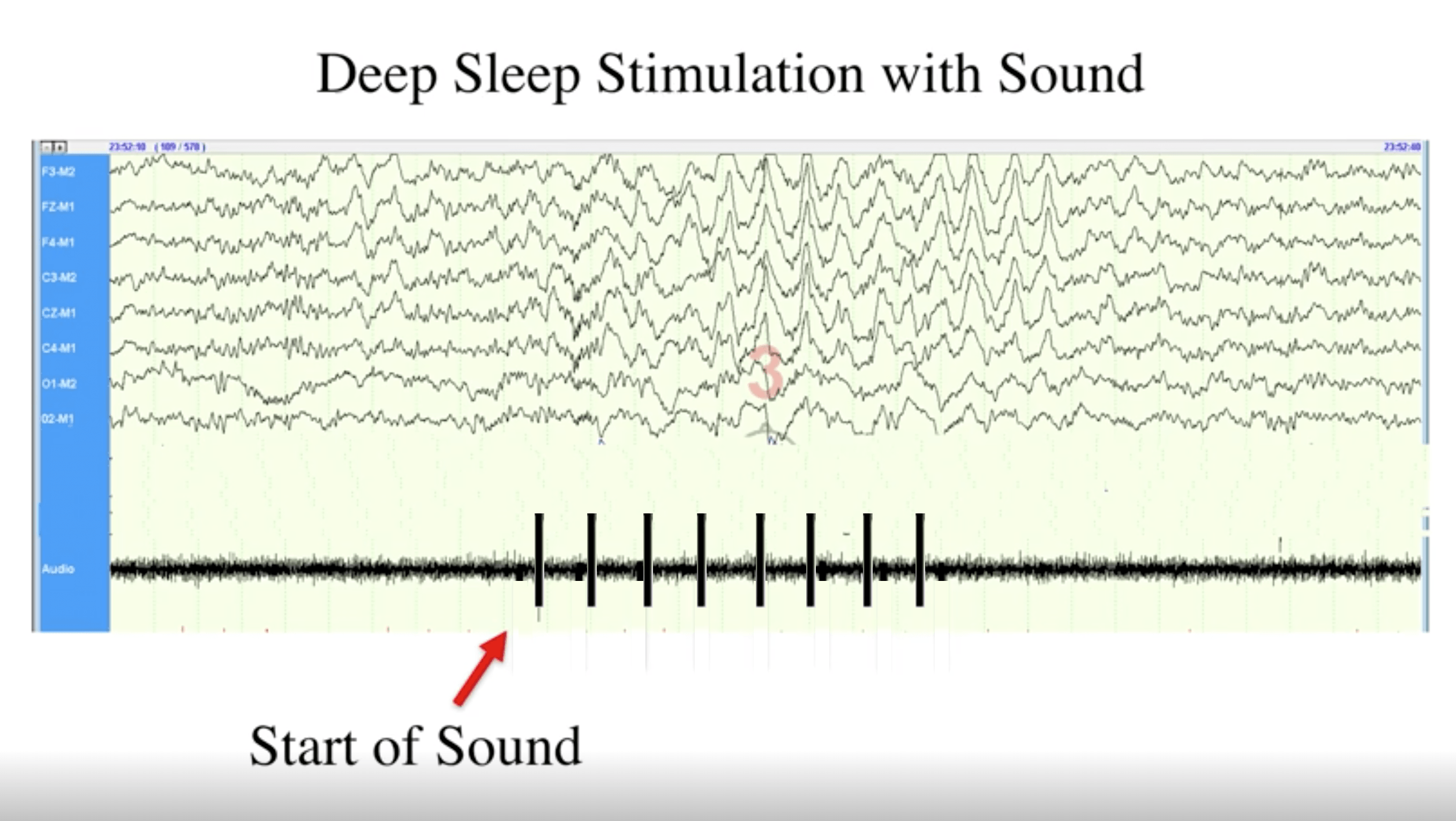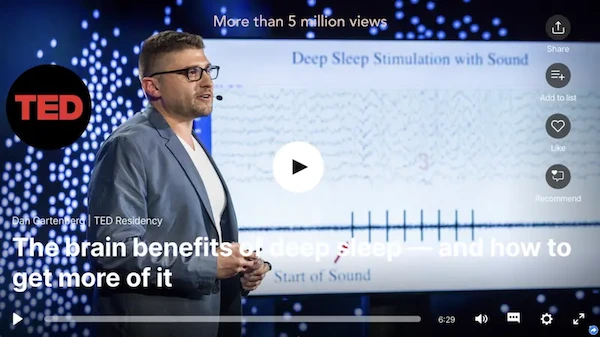Deep Sleep Stimulation
A Revolutionary Finding in Sleep Science for Increasing Delta Waves
Delta Waves
Scientists recently discovered that regenerative brainwaves can be increased using sound and electrical stimulation. This was the topic of our founder Dan Gartenberg's viral TED Talk, and the spark that ended up creating SleepSpace. But before we get into this revolutionary finding of deep sleep stimulation and how it works, let's first understand the basics of delta waves and how they regenerate the brain and body.
Our brain waves in deep sleep have long-burst brain waves that are very different from our waking life brain waves. These long-burst brain, with larger wavelengths, are called delta waves (see here for an overview of brainwaves during sleep). Scientists only recently discovered deep sleep when they connected the human brain to electrodes in the 1950s. This is when humanity first came across brainwaves, and the complicated brain activity that occurs during sleep. Researchers soon discovered that when we don’t get the deep sleep we need, it inhibits our ability to learn and for our cells and bodies to recover. Deep sleep (and REM) is how we convert all those interactions that we make during the day into our long-term memory and personalities. As we get older, we’re more likely to lose these regenerative delta waves. So in way, deep sleep and delta waves are actually a marker for biological youth. Deep sleep is related to clearing out harmful waste that forms in the brain, increased human growth hormone, and our ability to learn and remember.
Scientific Validation of Deep Sleep Stimulation
SleepSpace is leveraging cutting edge neuroscience research with more than $3.5 million in grants we received from the National Institute of Aging and National Science Foundation. One of these grants is entitled, non pharmacological improvement of sleep structure in older people and we just completed a randomized controlled trial of elements of this advanced technology in 2023.
In these grant we built a new system for delivering deep sleep stimulation non-invasively, using the power of sound waves. We showed that by playing the right sound, at the right time, we could increase regenerative delta wave amplitude and improve next day cognition. The goal of our research is to develop a deep sleep stimulation system on accessible consumer devices such as the Apple Watch, Fitbit, Google Watch, Oura Ring, and our patented nearable tracker called the SleepSpace Smart Bed.
Below are real brainwaves with the timing of our audio stimulation in the bottom panel. You can see that when the sound plays at just the right volume during the right stage of sleep, we are able to produce more regenerative delta waves. We have validated this finding in a peer reviewed publication. This technology is available for premium users of our iPhone and Android app and works best with the SleepSpace Smart Bed because it enables us to more precisely play the deep sleep stimulation sounds to one side of the bed. This is important because many people do not like sleeping with cumbersome earbuds.

Deep sleep stimulation with sound
10 years of cutting edge research has demonstrated that sounds can be used to entrain the brain into deeper sleep. In two of these studies, human subjects were stimulated during sleep with brief tones (50 millisecond duration) that were played via headphones or speakers between 0.8 and 2 Hz, a rate that approximated the natural cellular oscillation of cortical neurons during sleep. The auditory stimulation led to higher slow wave power compared to the flanking periods during which the stimulation was not present, with increases in slow wave power present during all 3 sleep cycles. Interestingly, tones were effective in increasing slow waves not only at the beginning of the night, when slow waves are more abundant, but even more effective later in the night when slow waves are typically fewer and smaller.
Two other papers also tested the effect of tones presented at a slow rate on SWA. When auditory stimulation started during wakefulness, before sleep, and continued for the first 90 min of sleep, it significantly delayed sleep onset. However, once sleep was established, 0.8-Hz stimulation significantly increased and entrained endogenous slow oscillation activity. This effect was stronger when auditory stimulation was given in phase with the ongoing rhythmic occurrence of slow oscillation up states. Importantly, the enhancement of declarative memory by auditory stimulation was observed in a paired-associated learning task, whereas sham stimulation did not enhance the retention of word-pair memories.
Our lab then replicated these findings. We showed that in a laboratory environment, a sleep technician could systematically administer deep sleep stimulation sounds that result in increased delta wave frequency. We are now in the process of validating this in a home environment using devices like the Apple Watch, Oura Ring, and Muse headset.

Check out SleepSpace CEO Dr. Dan Gartenberg's TED talk entitled, “The brain benefits of deep sleep – and how to get more of it,” with more than 4 million views
How to Use Deep Sleep Stimulation in SleepSpace
If you turn on the deep sleep stimulation mode in SleepSpace it will play the deep sleep frequency at the right time and volume in sleep. We can do this accurately in three different scenarios 1) With an Apple Watch, 2) With the SleepSpace Smart Phone Charger (slides under mattress to measure micro-motions), or 3) With your phone place on your mattress. We play the deep sleep stimulation sound loud enough for your brain to process it, but reduce the volume if we detect an awakening. In this way, we can play the sound to enhance your regenerative delta wave sleep. Below is a graphical representation of how it works.

Citations
Riedner B.A., Bellesi M., Hulse B.K., Santostasi G., Ferrarelli F., Cirelli C., and Tononi G. (2013) Enhancing slow waves using acoustic stimuli. Sleep 36, A41.
Tononi G., Riedner B.A., Hulse B.K., Ferrarelli F., and Sarasso S. (2010) Enhancing sleep slow waves with natural stimuli. MedicaMundi 54, 73-79.
Ngo H.V., Claussen J.C., Born J., and Molle M. (2013) Induction of slow oscillations by rhythmic acoustic stimulation. J. Sleep Res. 22, 22-31.
Ngo H.V., Martinetz T., Born J., and Molle M. (2013) Auditory closed-loop stimulation of the sleep slow oscillation enhances memory. Neuron 78, 545-553.
Schade, M. M., Mathew, G. M., Roberts, D. M., Gartenberg, D. & Buxton, O. M. Enhancing Slow Oscillations and Increasing N3 Sleep Proportion with Supervised, Non-Phase-Locked Pink Noise and Other Non-Standard Auditory Stimulation During NREM Sleep (2020). Nature and Science of Sleep. PDF